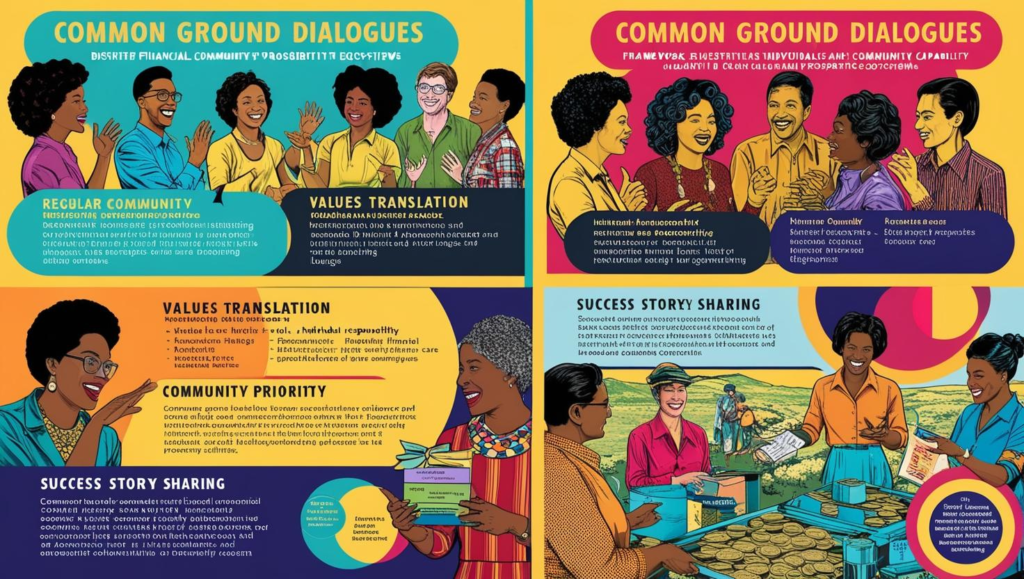How Do We Get There?

Building Bridges Across Perspectives
- Common Ground Dialogues: Regular community conversations where diverse stakeholders identify shared financial priorities despite differing worldviews.
- Values Translation: Frameworks that help translate between individual responsibility language and community care language to find underlying agreement.
- Success Story Sharing: Highlighting examples where personal initiative and community support have successfully worked together.
Practical First Steps
- Asset Mapping: Collaborative inventory of community financial strengths that all stakeholders can agree upon as foundations.
- Small Wins Strategy: Starting with modest projects that demonstrate the effectiveness of balanced approaches to financial capability.
- Cross-Sector Leadership Teams: Formation of diverse steering committees with representation from business, neighborhoods, and civic organizations.
From Division to Collaboration
- Shared Measurement Systems: Developing indicators that matter to both community-focused and individual-responsibility advocates.
- Principled Pragmatism: Commitment to focusing on “what works” rather than ideological purity in financial approaches.
- Respectful Dissent Protocols: Frameworks for productively addressing disagreements without derailing collaborative progress.
Sustaining the Partnership
- Celebration of Multiple Contributions: Regular recognition of how different perspectives strengthen community financial capability.
- Balanced Storytelling: Communication that honors both personal success stories and community achievement narratives.
- Legacy Planning: Multigenerational vision for sustaining balanced financial approaches beyond current leadership.
Creating a New Consensus
- Community Financial Charter: Development of shared principles that bridge self-reliance and mutual support values.
- Balanced Policy Advocacy: Joint efforts to promote legislation that supports both business growth and community networks.
- Cultural Integration: Weaving traditional values of individual responsibility with community interconnection into a cohesive local identity.
Circular Economy & Micro-Enterprise Development
Keeping Resources Local
- Community Wealth Circulation: Systems ensuring dollars spent locally generate multiple rounds of economic activity before leaving the community.
- Resource Reclamation Networks: Micro-enterprises transforming community “waste” into valuable products and services.
- Skills-to-Market Pathways: Programs helping residents convert traditional knowledge and household skills into marketable offerings.
- Buy Local, Hire Local Campaigns: Initiatives encouraging community members to prioritize neighborhood businesses in purchasing decisions.
- Local Currency Systems: Alternative exchange mechanisms that can only circulate within the community economic ecosystem.
Rural-Urban Connections
- Market Bridges: Direct trade relationships between rural producers and urban consumers without corporate intermediaries.
- Complementary Production Networks: Coordinated planning between rural and urban micro-enterprises to reduce competition and maximize mutual support.
- Knowledge Exchange Visits: Regular opportunities for rural and urban entrepreneurs to learn from each other’s contexts and approaches.
- Shared Distribution Infrastructure: Cooperatively owned systems for moving goods between rural and urban communities.
Micro-Enterprise Ecosystems
- Neighbor-to-Neighbor Business Mentoring: Experienced small business owners providing guidance to emerging entrepreneurs.
- Micro-Lending Circles: Community-based capital access independent of traditional banking requirements.
- Home-Based Business Incubation: Support for enterprises that can start in residential settings with minimal capital.
- Cooperative Business Development: Shared ownership models allowing entrepreneurs to pool limited resources.
- Skills Bartering Networks: Systems enabling micro-enterprises to exchange services without cash transactions.
Community Business Infrastructure
- Shared Commercial Kitchens: Collectively maintained facilities for food-based micro-enterprises.
- Neighborhood Marketplaces: Accessible, low-cost vending spaces for home-based businesses to reach customers.
- Mobile Retail Solutions: Community-owned carts, trucks, and pop-up structures serving entrepreneurs without storefronts.
- Technology Access Hubs: Shared digital resources enabling even the smallest enterprises to access online markets.
- Micro-Manufacturing Spaces: Communal workshops where residents can produce goods with equipment they couldn’t afford individually.
Self-Reliance Through Interdependence
- Skills Inventories: Mapping community capabilities to identify opportunities for local production of currently imported goods and services.
- Import Substitution Planning: Strategic development of micro-enterprises to replace external products with locally produced alternatives.
- Community Production Challenges: Neighborhood-wide efforts to collectively develop capacity for meeting specific local needs.
- Cross-Generation Business Succession: Systems ensuring valuable community enterprises continue beyond individual entrepreneurs.
By nurturing these interlinked systems of micro-enterprises and circular economic activity, we create prosperity that remains within our communities rather than being extracted by distant corporations. This approach honors individual initiative and entrepreneurship while recognizing that truly sustainable businesses thrive within supportive community networks. Whether in rural towns or urban neighborhoods, these interconnected local economies create resilience, enhance self-sufficiency, and build financial capability that benefits everyone. Through deliberate rural-urban connections, we overcome artificial divisions and create regional prosperity ecosystems where communities support each other’s unique strengths and contributions.
Common Ground: Where Share Purpose Drives Collective Prosperity
The Path Forward
This series isn’t about overnight transformation. It’s about steady progress on a path we walk together. It’s about building knowledge that translates into real-life confidence and capability.
Because we see you—your challenges, your potential, your future—and we’re here to walk alongside you, one step at a time.
Contact Common Ground today to discover which program meets you exactly where you are on your financial empowerment journey.
